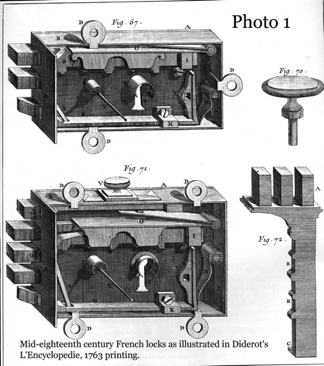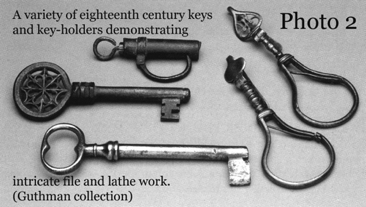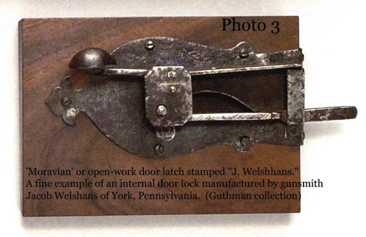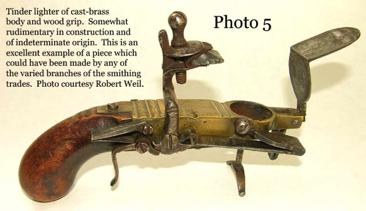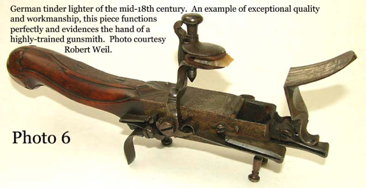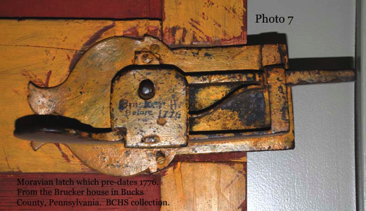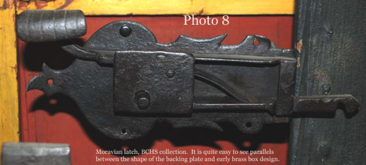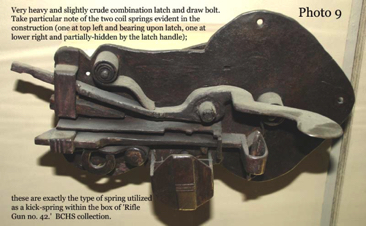Simon Leidacre of the Town of Northampton, Locksmith.
Information concerning Simon Leidacre [one spelling variant] is somewhat sparse and has been extremely difficult to uncover. The earliest record referring to this man refers to this arrival in Philadelphia on August 15, 1750 aboard the Royal Union (Strassburger 149C) at which point he took the Oath of Allegiance to the Province of Pennsylvania as "Simon Leytecker." Where he went immediately after arriving in Philadelphia is unknown, but the Berks County tax lists for 1758, 1759 and 1760 list Simon Laydecker in Long Swamp [a sub-district of Rockland township, this district being properly established as Longswamp township in 1761] as a married man. (HSP MFilmXCt Pa.Be.4) [According to Montgomery's History of Berks County of 1886, a "Valentine Leydecker" was also noted as a married man in Long Swamp for 1759 only, however no additional mention of this man has been found in any extant records and the HSP microfilmed tax list does not evidence this name. Most likely, Montgomery was utilizing a different list which may not have survived to be subsequently placed on microfilm. Who was Valentine?] Following this, "Simon Leidacker" again materializes February 13, 1761 whereby Simon Leidacker and Francis Cooper, both of the town of Northampton, were announced as principal creditors of one Nicholas Schrick [Schreck], deceased. (Eyerman file 389) A little over one year later, a petition was read before the Justices of the Court of General Quarter Sessions of the Peace held at Easton on September 21, 1762: Rudolph Smidt of Salisbury township (which lies immediately adjacent to Allentown to the south and east) wanted a license for an inn and tavern at the intersection of the road which ran from Allentown ["...a new town on Great Lehigh..."] to Philadelphia with the road which ran west from Bethlehem into Berks County. This petition was signed by seventy-three men of the vicinity including "Simon Layendecker." The following year, 1763, Simon again signed a letter or petition to James Hamilton, Lieutenant-Governor of Pennsylvania [see below], and in 1764 "Simon Leitdecker" was noted upon the earliest surviving tax list for Northampton Town proper [previous assessment records do not effectively distinguish residents of the slowly-growing town from the larger "Allen" Township or "Allen's Town" Township as a whole]. He was again listed upon the assessment for 1765; for this year, he was noted as owning one lot with one house upon it and one cow but no horse. (HSP MFilmXR 701) It was also during this year that a deed was recorded on June 1, a summary of which is as follows:
Grantor: William Allen Esquire of Philadelphia to Grantee: Simon Leidacre of the town of Northampton, locksmith. Date: 1 June 1765. Amount: "...for the consideration of the charges and expenses which Simon Leidacre has already expended in building upon and improving the lot of ground and for the rent, conditions and covenants agreed upon as well as the sum of 5 shillings..." Description: A lot of ground on the west side of James St. in the town of Northampton bounded on the north by vacant lot no. 494, east by James St., south by vacant lot no. 492 and west by a public alley. Containing in front 60 feet and in depth 230 feet being lot no. 493 in the plan. A yearly rent of 9 shillings to be paid to William Allen. If rent is not paid, William Allen reserves the right to enter the property and seize sufficient items to be auctioned in order to secure sufficient payment. If such items can not be found, the entire lot may be repossessed and sold. Witnesses: Lewis Gordon and Alexander Stuart.
(Northampton Co. Deed Book C1, p. 249-252)
In 1766 he was curiously absent from the assessment list which has been placed on microfilm at HSP, but he reappears in 1767 as Simon Lagundecker [or Layundecker]. (HSP MFilmXR 701) Following this, he permanently disappears from the Northampton County tax lists [which are partially missing and partially incomplete for certain years] and by the time the extremely thorough 1772 Proprietary Supply tax was recorded (3 PA Archives XIX), he is no longer listed as being present anywhere within Northampton County.
A brief diversion should be made to better explain and understand the term "locksmith" within the context of the period. Colonial American locksmiths were metalworking artisans with a high degree of skill and generally worked upon a wide range of products - not simply locks - of much more intricate aspect than the general blacksmith. Of course locks and keys were produced, the manufacture of which mandated training in welding and brazing, riveting, careful filing and polishing, screw-making and lathe work, creation and tempering of springs etc. Additionally, locksmiths worked in a variety of metals including iron and steel, brass, copper and tin plate. While there is very little extant literature to better define the parameters of the trade within the Colonies, it would seem that here - where a rigid guild system was not exercising the role of trade overseer - the lines between the various smithing occupations were quite blurred. The relation between locksmiths and gunsmiths and/or gunstockers has not been thoroughly explored and is subject to a great deal of speculation. The study of antique tinder lighters is an excellent example of this confusion: some function flawlessly, are of wonderful quality and bear witness to strong familiarity with the requisites of a perfectly-functioning flintlock. Were such fine examples made by gunsmiths? Others appear much simpler, do not seem to possess the same level of familiarity, evidence a high constructive reliance upon brazing and are often viewed as being the products of locksmiths/whitesmiths. Amongst German-speaking people there would seem to have been a relatively clear division of labor as the terms Schlosser, Buchsenschmidt, Buchsenmacher and Buchsenschafter [Locksmith, Gunsmith, Gunmaker and Gunstocker] are variously found throughout period records both in Germany and in America. Were locksmiths involved in the manufacture of gun locks? The segment entitled "The Gunmaker and the Gunstocker" within Sprengel's Handwerke und Kunste in Tabellen of 1771 ["Handwork and Artifice Summarized"] states that it was the "Buchsenmacher," or gunmaker, who forged and assembled the flintlock mechanism (Nicolai/Bivins 59-80) There does seem to exist, however, a recurring popular notion that locksmiths may have at times also been involved in such gun-related production.
Wallace Gusler's March, 2005 article within Muzzle Blasts magazine ["An Eighteenth-Century North Carolina Moravian Rifle Gun"] blatantly flirts with the notion of locksmithing influence or involvement in the development of various early box release mechanisms (Gusler 53-57), and it certainly is difficult to view the accompanying photos of such mechanisms without consideration of similar technology employed in the creation of contemporary locks. Amongst the Moravians in Bethlehem, Andreas Betz was a journeyman locksmith and one-time master of the locksmith shop (MAB) before traveling to Bethabara on the Wachovia tract [North Carolina] in 1754, where he initially worked in the smithy with blacksmith George Schmidt (Fries v1, 148), and as early as 1756 was executing repair work upon guns despite continuing to work in a single generalized smith-shop: "A bear hunter brought his gun to our gun-smith..." (Fries v1, 173) Jacob Loesch Jr., who briefly supervised the gunshop at Christian's Spring ca. 1779-1781 [exact dating has not been perfectly clarified as yet; Lienemann/MAB] was noted as a "lock-smith" upon his arrival in Salem, NC, in 1781, and was specifically requested not to work upon guns at that time. (Fries v4, 1738) By 1783, however, Loesch was given permission to commence gunsmithing and in 1784 took Christopher Vogler as apprentice. (Fries v5, 2036). These are merely two well-documented examples of men, both noted locksmiths, who probably were possessive of high levels of mechanical skill and thus were able to exercise much latitude in their craft.
Moravian records concerning the shop of the 'Locksmith and Gunstock Maker' in nearby Bethlehem ca. 1755-1762 indicate a huge variety of work. Locks and keys, hinges, screws, saddle mountings, center bits, coffee roasters, mold work and graving work, much gun lock repair and assorted arms repair, a wide range of tools being sold and repaired, pipe heads: the range of projects and list of items mentioned is enormous. (Lienemann/Moravian Archives Bethlehem) This may or may not have been typical of many American locksmith shops, and of course it is possible that the heavy involvement in gun work was due to the presence, even if only intermittent, of a 'Buchsenschafter.' It is also not clear whether some/all of the gun locks being sold were purchased items destined for resale, or flintlocks made within the shop; this lack of clarity actually can be equally applied to a number of the iron and brass items mentioned - made or purchased [Philadelphia and/or more local merchants]? Possibly, as the records would seem to indicate, a little of both.
Many of the products of the locksmith were easily available as import items via shopkeepers and merchants in Philadelphia: "To be sold by Thomas Maule, At the sign of the Cross cut saw, in Second street, near the English church, The best and newest fashioned brass handles for drawers or desks, brass knobs for desks, sets of brass locks and hinges for desks or doors, brass nobs for ditto, brass kettles, brass padlocks, iron ditto, chest locks and hinges, cupboard locks..." (PA Gazette, May 3, 1750) Later that same year Maule also advertised "...most sorts of locks for drawers, desks and doors, HL hinges... pepper mills, box irons and stands, brass candlesticks with screws, iron candlesticks... snuffers... chafing dishes, warming pans... mouse traps..." (PA Gazette, Dec. 25, 1750) One of Maule's competitors, Samuel Burge, on September 6, 1750, advertised much of the same including "...best bridle gun locks..." (PA Gazette) The availability of such items - apparently common to the urban center of Philadelphia - in the 'frontier' of Northampton County is unknown, however by 1763 at least one "Stage Waggon" was running a circuit from Philadelphia to Bethlehem every Thursday morning and returning each following Monday "...with Passengers and Goods." (PA Gazette, Sept. 15, 1763)
Returning to a focus upon Simon Leytecker in nearby Allen's Town, two additional notations worth mentioning can be found in the pre-1770 period, both drawn from the Goshenhoppen Register. Within the records pertaining to St. Paul's Mission, Church of the Most Blessed Sacrament, there are two references to Simon:
- Bisschof, Simon, of Peter Bisschof and his wife Mary Charlotte, born 5 March 1766, baptized 17 March in Kuhn's house. Sponsors Simon Legdekker and his wife.
- Jutz [possibly Butz], John Anthony, of Anthony J[B]utz and his wife Catherine, born 1 January 1769, baptized 5 January in Simon Leydecker's house. Sponsors John Faller and Mary Bischoff.
Goshenhoppen was a loose American Indian-based name given to the area where the eastern corner of Berks County, extreme southern Lehigh County [Northampton County until 1812], upper Montgomery County and the western corner of Bucks County all come together. St. Paul's Chapel was located near what is now Bally but which, prior to 1883, was referred to as Churchville; built in 1743, it was the first Catholic church in Berks County. Many of the records kept by Father Theodore Schneider are unfortunately missing for 1747 through 1758, at which point they are largely resumed and from whence the aforementioned two notations regarding Simon Legdekker/Leydecker are drawn. During this period - prior to and during the French and Indian War - Catholics were not trusted by the majority Lutheran population as is evidenced by a letter addressed to Deputy Governor Robert Hunter Morris dating to 1755. This letter was authored by five Berks County Justices of the Peace (Henry Harry, James Reid, William Bird, Jonas Seely and Conrad Weiser) and a portion of it reads as follows:
"...As all our Protestant inhabitants are very uneasy at the behavior of some of the Roman Catholics, who are very numerous in this county, some of who show great joy at the bad news lately come from the army, we have thought it our duty to inform Your Honor of our dangerous situation, and beg Your Honor to enable us, by some legal authority, to disarm, or otherwise disable, the Papists from doing injury to other people who are not of their vile principles.
We know that the people of the Roman Catholic Church are bounded by their principles to be the worst subjects, and worst neighbors; and we have reason to fear just now that the Roman Catholics in Goshenhoppen, where they have a magnificent chapel, and lately had large processions, have bad designs; for in the neighborhood of that chapel; it is reported, and generally believed, that thirty Indians are now lurking, armed, with guns and swords, or cutlasses.
The priest at Reading, as well as Goshenhoppen, last Sunday, gave notice to their people that they could not come to them again in less than nine weeks; whereas they constantly preach once in four weeks to their congregations: whereupon some imagine they've gone to consult with our enemies at DuQuesne.
It is a great unhappiness at this time to the other people of this Province that the Papists should keep arms in their houses, against which the Protestants are not prepared; who, therefore, are subject to a massacre whenever the Papists are ready.
We beg Your Honor would direct us in this important business by return of the bearer, whom we have sent express to Your Honor..."
(4 PA Archives II, 392)
Fortunately for the Berks County Catholics, nothing ever came of this letter.
Given this backdrop, an even more interesting letter has survived dating to 1763. The summer and fall of that year were bloody ones for the residents of "Allen's Town" and the upper townships along the Lehigh River and base of the Blue Mountain. Lewis Weiss wrote to Timothy Horsefield [at Bethlehem] on August 1, 1763, stating that he [Weiss] had spoken with the Governor's commissioners and informed them that he desperately needed arms - especially blunderbusses - for the defense of Bethlehem and Nazareth. Weiss went on to mention that one William Hoffman had "three swivels" for Bethlehem. (HSP MFilmXR 698) Eight days later, on August 9, Lieutenant Jonathan Dodge wrote from his station at Fort Allen to Horsefield in Bethlehem and stated that the guns supplied to his men were bad, "...not one in ten that would kill a man in ten times shooting." (HSP MFilmXR 698) Much additional information regarding this ongoing conflict between the militia, the settlers on the frontier and the neighboring Indians can be found in the text Frontier Forts of Pennsylvania Vol. 1 by Thomas Lynch Montgomery, pages 164-174. A particular incident which occurred October 8 and 9 of 1763, sometimes referred to as the "Whitehall Massacre," so frightened the residents of the area that many fled to Bethlehem or Nazareth while the men of Northampton Town (and vicinity) immediately formed a company for the defense of their homes. On October 10 of 1763 a letter was dispatched from Northampton which read as follows:
"Northampton Town, the 10th of this Instant, Octbr, 1763.
To the Honourable JAMES HAMBLETON, Esqr., Lieutennent Governeur and Commander
in Chief of the Province of Pennsylvania, Newcassel, Cent and Sasox, on Dalawar.
We send Greeting:
As I, Joseph Roads, of Northampton Town, Church Minister, of the Eighth of this Instant, Octbr, as I was a preaching, the people came in such numbers that I was abliged to quit my Sarman, and the Same time Cornel [Colonel] James Bord was in the Town, and I, the aforesaid Minister, Spoke with Cornel Bord, concerning this afarres of the Indians, and we found the Inhabitance that the had nither Gons, Powder, nor Lead, to defend themselves, and that Cornel Bord had Latly spoke with his Honour. He had informed me that we would assist them with Gons and Ammunition, and he requested of me to write to your Honour, be cause he was just setting of for Lancester, and the Inhabitance of the Town had not chose their officers at the time he set of, So we, the Inhabitance of the said Town hath Unahimus Chose George Wolf, the Bearer hereof, to be the Captin, and Abraham Rinker to be the Lieutennet; we hose Names are under writen promiss to obey to this mentioned Captin and Lieutennet, and so we hope his Honor will be so good and send us 50 Gons, 100 Pounds of Powder and 400 Pound Lead, and 150 Stans for the Gons. These from your humble Servant, Remaining under the Protection of our Lord Saviour, Jesus Christ.JACOB ROTH, Minister.
The Names of the Gospel of this said Northampton Town.
George Wolf, Captain Jacob Wolf Martin Frolick
Abraham Rinker, Lieutennet Simon Lagundacker Georg Laur
Phillip Koogler Georg Nicholaus Daniel Nonnemaker
Peter Miller David Deschler Peter Shab
Frederick Schakler John Martin Dourr Abraham Sawitz
Leonhard Abell Peter Roth John Schreck
Tobias Dittis Fraz Keffer Georg S. Schnepp
Lorenz Stauk Jacob Morr Michael Readcot
Simon Brenner"
(1 PA Archives IV, 124)
[A brief letter from Colonel James Burd to Governor Hamilton relative to this incident was written from Lancaster on October 17, 1763, and can be found at 1 PA Archives IV 125. It reads as follows: "Sir: I arrived here on Monday night from Northampton, I need not trouble your Honor with a Relation of the Misfortune of that County, as Mr. Horsfield told me he would Send you an Express, and inform you fully of what happen'd; I will only mention, that in the Town of Northampton, (where I was at the time) there was only 4 Guns, three of which unfit for use, & the Enemy within 4 miles of the place…”]
This is a very interesting letter as Simon, a Catholic, was putting his name to a document written by a Lutheran minister. The "names of the Gospel" of Northampton do not represent all of the adult males of the town as of October 10, 1763, and some of the men listed were residents of the larger township as a whole, so evidently Simon was trusted enough or well-known enough to be taken-on as part of the newly-forming defensive militia. Taking into consideration the regional distrust and dislike of "papists," this creates something of a mystery: were his neighbors aware that he was Catholic? Were the struggling inhabitants of Northampton perhaps placing higher value on manpower than on religion? These questions can not currently be answered. Allen's Town at the time was approximately 20 miles northeast of St. Paul's Church [which was extremely close - within a few miles - to Simon's previous home in Longswamp township, Berks County]. As is evident through the Goshenhoppen registers as well as the aforementioned letter of 1755, services at the church itself may have only been held as frequently as once per month while the majority of the baptisms and other relevant ceremonies were performed by the priest traveling a circuit of parishoners' homes. It would appear that by 1767, despite the relatively small population of the town itself, the surrounding area must have been home to a larger population of Catholics as shown by the following petition:
"To the Honorable JOHN PENN, Esqr, Lieutenant Governor of the Province of Pennsylvania, &ca., &ca.
The Petition of the Congregation of Roman Catholics of the town of Northampton and other Places adjacent, Humbly Sheweth:
That your Petitioners are about to build a Church for the Worship of God in the Town of Northampton, & have already provided Materials for putting their Design in Execution. But they fear the Inability of your Petitioners is likely to render their good Intentions fruitless, unless they are at liberty to ask Assistance from charitable & piously disposed People. They therefore humbly intreat your Honor to grant them a Licence for the said Purpose; whereby they may have the peaceable & quiet enjoyment of their Religion according to the Laws of the Province, & Reap the Benefit of those Privileges granted them by your Honor's Benevolent Ancestors. And your Petitioners, as in Duty bound, will ever pray for your Honor's and Family's Welfare.
JOHN RITTER
J.G. ENAX, and others.
To the Honorable JOHN PENN, Esquire, Lieutenant Governor of the Province of Pennsylvania, &c.
We, the Subscribers, Justices of the Peace of the County of Northampton, beg leave to recommend the above Petition to your Honor.
JAMES ALLEN,
JNO. JENNINGS,
LEWIS KLOTZ"
September 25, 1767.
(1 PA Archives IV, 279)
Father John Ritter was the successor to Father Theodore Schneider as priest of the St. Paul's Goshenhoppen congregation ca. 1764 - 1787 and it is likely that he was primarily a resident of Berks County. It can be safely assumed, being as he was writing on behalf of the Catholics of Northampton Town and the surrounding area, that there must have been a sufficient population of area Catholics within his usual circuit to warrant the addition of a regional church. This project was unfortunately never carried to completion and so the area Catholics were forced to continue a reliance upon St. Paul's Church in Berks County for their ministrations.
In 1769, Simon Leidacre and his wife sold their lot in Northampton Town and thus completely disappear from the extant records (summary):
Grantor: Simon Leidacre and wife Catherine to Grantee: Simon Brenner of Northampton Co. Date: 11 Jul. 1769. Amount: 18.0.0 pounds. Description: Lot # 493 as described in Deed Book entry C1-249. The described property remains subject to all the previously described covenants and conditions. Signed: Simon Leidacker <SEAL> Cathrina Leidacker <mark> Witnesses: George Dimbrel/Dinbiel [very difficult to read], Bastian Oboes.
(Northampton Co. Deed Book C1, p. 251, Endorsement)
Why did Simon and Catherine sell their home and where did they go? Did they move back to Berks County - nearer St. Paul's Mission and a larger Catholic community - following the failed attempt to build a Catholic Church in Northampton? A systematic search of extant Berks County records has failed to discover them. It is believed [family correspondence] that Catherine Leidecker, Simon's wife, was a daughter of Simon Brenner whose name is found within most of the above-referenced documents. ["Simon Brener" arrived via the ship Phoenix on Sept. 25, 1751 (Strassburger 173C)] If so, this would mean that Simon Leidacre was selling his lot in Northampton to his father-in-law, however I have not seen any documentary evidence to this effect]. The possibility also exists that if husband and wife remained within the house as tenants, they might have disappeared from the tax lists while Simon Brenner continued to be listed as paying taxes: this is not a situation which was necessarily common to southeastern Pennsylvania assessments, as tenants were sometimes noted, however it was not a rare occurrence either. Unfortunately there is no definitive way to be certain. Tax lists do not always tell the entire story, as many researchers will inevitably find that numerous individuals who can otherwise be proven via church or census records to have been present in a particular area do not manifest upon the assessments [and in fact Simon was absent from the 1766 list]; conversely, it is equally unfortunate that there are many later instances of men listed upon tax records who apparently avoided the census-takers.
A few years later in 1775, the same parcel again changed hands (summary):
Grantor: Simon Brenner, carpenter of Northampton County to Grantee: Dewalt Miller, joiner of the town of Northampton. Date: 13 Apr. 1775. Amount: 30.0.0 pounds. Description: The same property as described in Deed Book entry C1-249 and the Endorsement recorded in Deed Book C1-251. Signed: Simon Brenner <SEAL> Witnesses: Martin Frolich, R. Backhouse.
(Northampton Co. Deed Book C1, p. 252)
One item of interest which is somewhat unexplained is the question of why, in both transactions involving Simon Brenner, he is described as being "...of Northampton Co." when - through 1772 at least - he was consistently noted upon the assessment lists as residing within Northampton Town. This might seem insignificant, save that in the final deed the grantee is specifically designated a resident of the town proper. I am at a loss to explain this and attach no real meaning to it at present, other than that the subtle difference in semantics is noticeable. Brenner vanishes from later tax assessments, although obviously he still lived and owned the house upon lot #493 - if not actually residing within either it or the town - as late as April 1775.
As a final note, information regarding the birth or background of Simon Leytecker is currently unknown. One year after Simon's arrival, a second man of the same surname arrived at the port of Philadelphia aboard the ship Shirley (1751): his name upon the ship's passenger list (Strassburger 163C) is given as Johan Michael Leytecker but nothing is known of his subsequent location following this record. A third man, Nicholas Leyteker, arrived in 1752 aboard the Ann Galley (Strassburger 182C) and - as did Michael - subsequently disappeared. This rapid arrival of three men of the same surname within the same amount of years raises the very strong possibility that they were related, however this currently can not be determined. Any relationship which may have existed between Simon Leidacre/Layendecker, locksmith of Northampton Town, and Georg Leyendecher - also a locksmith or smith of some type and a resident of the same region - is currently a mystery, albeit a hugely suggestive one.
